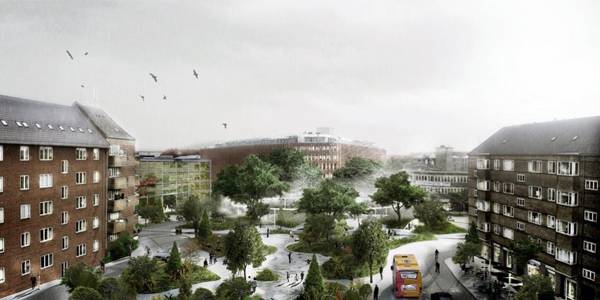The urban population is growing by the day, straining cities and causing a series of modifications – changes in the urban climate among them. The demand for more resources can make a city vulnerable to disasters such as floods (due to higher sea levels and excessive rain), heat waves, spread of diseases, etc. These negative consequences can be avoided through the implementation of specific strategies, such as climate-sensitive planning, that compromise thermal comfort and the consequent livability of cities. Copenhagen as role model Denmark is a country seriously committed to promoting awareness of urban resilience – the capacity of a city to recover from a difficulty (in this context, related to climate). St. Kjeld, in Østerbro, will be the first neighborhood in Copenhagen to have its layout adjusted to avoid disasters caused by climate change. The choice of this neighborhood in particular is related to its unnecessarily wide streets. Streets with more modest dimensions — still able to manage local traffic — would allow for better use of the urban space and significantly improve the lives of residents.
The main problem that affects the city is flood. The amount of rain water is such that the sewer system has not been enough; therefore, management of water resources is a priority in the interventions. To overcome this challenge, water towers and greener courtyards are being constructed, as well as rain gardens and more green areas (to provide more permeable surface). The Klimakvarter project is an initiative of the city of Copenhagen that aims to reach zero carbon emissions by 2025, as well as adapting the city’s structure. The talented architecture firm Tredje Natur is in charge of the planning and implementation of these innovative solutions. The architects are also counting on intense participation by local residents to make the most of the neighborhood’s potential. The project focuses on the following locations: Bryggervangen: They aim to create a green stream through the neighborhood, which will conduct excessive water to the harbors during heavy rains. St. Kjeld Square: This is a huge roundabout where the main neighborhood streets intersect. These streets are three times wider than local traffic demands, so the square will be expanded to reduce the paved area. This will be the “green heart” of the neighborhood. Tasinge Square: Today, Tåsinge Square is an overgrown bunker, rarely used by residents living around the square. The green area of the bunker is surrounded by beautiful buildings and sunny most of the day, which is why Tåsinge Square has a great potential to become a green venue where local cafés and cultural life can thrive. This square will be transformed into the cultural center of St. Kjeld. The streets here are oversized, which is detrimental to all; therefore, it is proposed that a street be closed for expansion of the green area, creating a better situation for drivers, pedestrians, and cyclists. In addition to the areas mentioned above, enclosed courtyards will also be included in the planning. Their intimate character will be preserved to encourage more use. Urban planning + urban climatology The main objective of the project is to make St. Kjeld more resistant to the climate changes predicted for the particular reality of Copenhagen, but it goes beyond that: Adapting the neighborhood and offering solutions that will leave the city (even more) attractive will make it a beautiful and inspiring example for us all, demonstrating environmental, cultural, economical, and social concern. Within the overall context of the uncertainty surrounding climate change, cities should provide a pleasant experience for the population, improving the quality of urban life and encouraging the use of outdoor spaces. Given the current concern about sustainable development, landscape architects and urban planners are now paying more attention to the aspects of urban climate parameters and incorporating them into their work as design parameters. Indeed, a better understanding of the urban climate can serve as an important guide in building more sustainable cities. To reverse the fragile situation of cities is a challenge for many – landscape architects and urban planners included. For more information on this incredible initiative check out their PDF Or visit their website www.tredjenatur.dk Article written by Julia Lucchese Published in BlogLogin
Lost Password
Register
If this is your first time on the new site, please click "Forgot your password?". Follow the steps to reset your password. It may be the same as your old one.
















